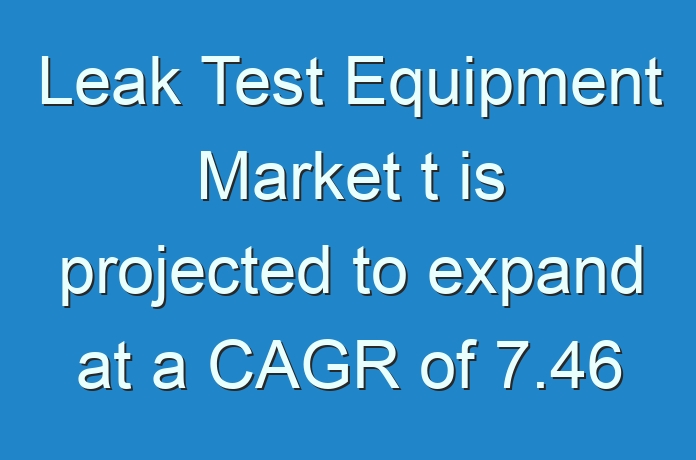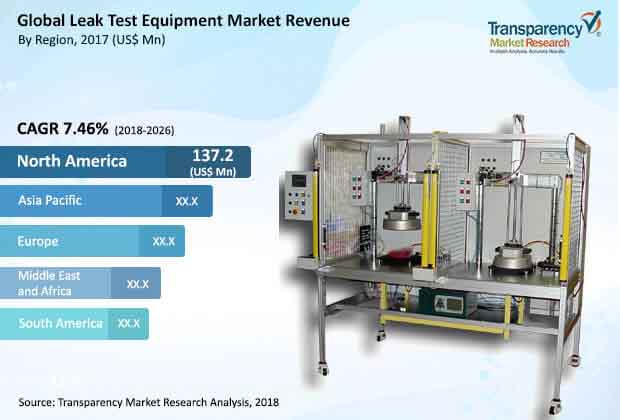
The global leak test equipment market was valued at US$ 377.0 Mn in 2016 and is projected to expand at a cumulative annual growth rate (CAGR) of 7.4% from 2018 to 2026, according to a new report published by Transparency Market Research (TMR) titled “Leak Test Equipment Market – Global Industry Analysis, Size, Share, Growth, Trends, and Forecast, 2018–2026”. The report suggests that expansion of the global automotive, medical & pharmaceutical, and packaging industries along with increasingly stringent regulations pertaining to leakages is likely to spur the demand for leak test equipment during the forecast period (2018 to 2026).
Rising cost of helium, used as a tracer gas in leak test equipment, to restrain the global market
Leak testing procedures are essential to ensure superior quality of the product along with safety of consumer. However, a large number of industry verticals are facing problems due to the rising cost of helium gas, as helium supply is facing a shortage worldwide. Helium is a naturally-occurring gas that is utilized for numerous purposes across various fields. A significant number of industries rely on helium leak testing methods, as helium is a highly popular tracer gas in leak testing production.
However, the demand for helium is exceeding the available supply, due to the higher usage of helium across various industries, which has been raising the cost of helium in recent years. Several companies are presently using alternative equipment that employ air leak testing method, as this type of leak test equipment utilizes affordable hydrogen gas, rather than costly helium. However, for some companies, altering a procedure that is established can be a difficult task, as wrong decision pertaining to the leak test method can compromise the quality of the products.

For More Details, Request A Sample Report@ https://www.transparencymarketresearch.com/sample/sample.php?flag=S&rep_id=42812
Significant expansion of the automotive & transportation end-use industry, making it highly lucrative to invest in
Based on end-use industry, the leak test equipment market is segmented into HVAC/R, automotive & transportation, medical & pharmaceutical, packaging, industrial, and others. The others end-use industry segment includes aerospace & defense and power & energy end-use industries. The automotive & transportation segment is expected to expand at a CAGR of more than 7% during the forecast period. A large number of automotive manufacturers around the globe rely on higher quality leak test equipment to find defects in automotive components or products. Manufacturing defective products can prove costly, as it results in increasing warranty claims and endangering safety of the consumer. The leak testing procedures for the automotive are primarily defined by different standard organizations including the American Society for Testing and Materials and the Society of Automotive Engineers.
North America is a prominent market for leak test equipment
In terms of value, North America held a major share of the global leak test equipment market in 2017. The high market share is primarily due to the presence of well-established players across the region, especially in the U.S. and Canada. North America is a home to numerous well-established players operating in the leak test equipment market including Uson, L.P., Vacuum Instruments Corporation, LLC, ATEQ Corp., InterTech Development Company, and LACO Technologies. Furthermore, North America is witnessing a higher rate of adoption of leak test equipment due to the consistent expansion of the automotive industry.
Key players such as INFICON, Pfeiffer Vacuum GmbH, Uson, L.P., and ATEQ Corp. among others are likely to lead the global leak test equipment market
Uson, L.P., Vacuum Instruments Corporation, LLC, Pfeiffer Vacuum GmbH, CETA TESTSYSTEME GmbH, ATEQ Corp., InterTech Development Company, LACO Technologies, and INFICON are some of the major players operating in the global leak test equipment market profiled in this study. Various players are providing novel leak test equipment to detect manufacturing defects, which helps validate the product’s integrity in order to improve safety of the customer. Moreover, market players are establishing partnerships, entering into strategic M&As, and expanding in order to enhance their leak test equipment offerings worldwide.





